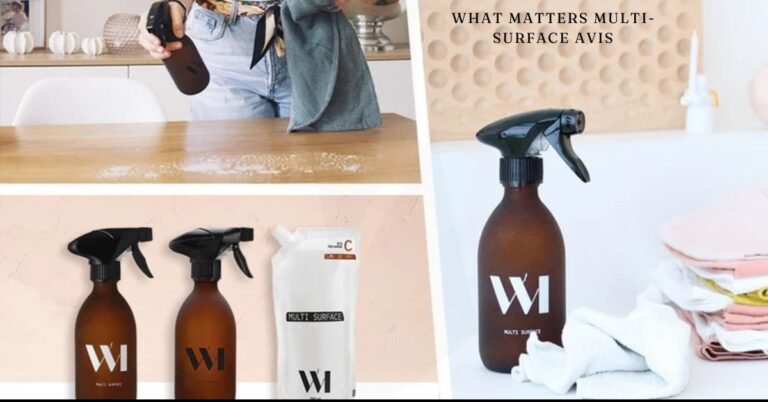Introduction
When it comes to keeping your home clean and well-maintained, choosing the right multi-surface cleaner is crucial. With countless options on the market, understanding what makes a product effective and safe for various surfaces can be overwhelming. In this in-depth guide, we explore “what matters multi-surface avis”—providing a well-rounded analysis of top-rated products, their benefits, and how they compare against each other.
Whether you’re looking for a cleaner that works on wood, glass, stainless steel, or marble, this article will help you make an informed decision. We’ll also highlight key factors such as ingredients, safety, environmental impact, and efficiency. Let’s dive in!
What is a Multi-Surface Cleaner?
A multi-surface cleaner is a versatile cleaning solution designed to work on different types of surfaces without causing damage. These cleaners help remove dirt, grease, grime, and bacteria from countertops, furniture, kitchen appliances, and more.
Why Choose a Multi-Surface Cleaner?
- Convenience: Instead of buying multiple products for different surfaces, a single bottle can cover multiple cleaning needs.
- Cost-Effective: Saves money by reducing the number of cleaning products needed.
- Time-Saving: Eliminates the need to switch between different cleaners, making cleaning quicker and more efficient.
- Eco-Friendly Options: Many brands now offer biodegradable and non-toxic formulas that are safe for both humans and the environment.
Key Ingredients in Multi-Surface Cleaners
- Surfactants: Help break down grease and dirt.
- Disinfectants: Kill bacteria and viruses.
- pH Balancers: Ensure the cleaner is safe for different materials.
- Natural Oils & Extracts: Found in eco-friendly versions to provide a pleasant fragrance and antibacterial properties.
What Matters in a Multi-Surface Cleaner?
Effectiveness on Various Surfaces
A good multi-surface cleaner should work efficiently on the following surfaces without leaving streaks or residue:
- Wood
- Glass
- Granite
- Marble
- Stainless Steel
- Ceramic
- Plastic
Safety Considerations
- Non-Toxic Ingredients: Ideal for households with children and pets.
- Skin and Respiratory Safety: Avoid products with harsh chemicals that can cause allergies or irritation.
- Food-Safe Formulas: For kitchen surfaces, opt for cleaners that don’t leave harmful residues.
Scent and Residue
Some people prefer unscented options, while others enjoy fresh or citrus-scented cleaners. Additionally, a good cleaner should not leave a sticky or greasy residue after use.
Top Multi-Surface Cleaners Reviewed
Below, we compare some of the best multi-surface cleaners available today, highlighting their pros and cons.
| Product | Best For | Key Features | Pros | Cons |
|---|---|---|---|---|
| Lysol Multi-Surface Cleaner | Disinfecting | Kills 99.9% of germs, works on multiple surfaces | Effective, affordable, pleasant scent | Contains chemicals |
| Method All-Purpose Cleaner | Eco-friendly use | Plant-based formula, biodegradable | Non-toxic, safe for kids & pets, great fragrance | May require more scrubbing |
| Mrs. Meyer’s Multi-Surface Cleaner | Natural option | Essential oils, cruelty-free | Gentle, smells great, works well on most surfaces | Slightly expensive |
| Seventh Generation Disinfectant | Non-toxic disinfecting | Botanical-based disinfectant, fragrance-free | EPA certified, safe for sensitive individuals | Can be less effective on grease |
How to Choose the Best Multi-Surface Cleaner
1. Identify Your Cleaning Needs
Consider whether you need a cleaner primarily for disinfecting, degreasing, or general everyday cleaning.
- For kitchens and food-prep areas: Opt for a non-toxic and food-safe formula.
- For high-traffic areas: Choose a disinfectant to eliminate germs effectively.
- For delicate surfaces like marble and wood: Ensure the cleaner is pH-balanced to avoid damage.
2. Read Product Labels Carefully
Look for certifications such as EPA Safer Choice, USDA BioPreferred, or Green Seal to ensure the product is environmentally friendly.
3. Consider Ease of Use and Packaging
- Spray bottles provide better control and even application.
- Concentrated formulas allow for dilution, making them more cost-effective.
- Wipes are convenient for quick clean-ups but generate more waste.
4. Compare Price vs. Value
Sometimes, a slightly more expensive product lasts longer due to its concentrated formula, making it a better investment over time.
DIY Multi-Surface Cleaner Recipe
If you prefer a homemade, natural alternative, here’s an easy DIY recipe:
Ingredients:
- 1 cup white vinegar
- 1 cup distilled water
- 1 tablespoon baking soda
- 10 drops of essential oil (lemon, lavender, or tea tree for fragrance and antibacterial properties)
Instructions:
- Mix all ingredients in a spray bottle.
- Shake well before each use.
- Spray on surfaces and wipe clean with a microfiber cloth.
This homemade cleaner is non-toxic, effective, and environmentally friendly.
Common Mistakes to Avoid When Using Multi-Surface Cleaners
1. Using the Wrong Cleaner on the Wrong Surface
Some products contain ingredients that can damage delicate materials like marble, granite, or untreated wood. Always read labels carefully.
2. Not Allowing the Cleaner to Sit
For disinfecting, allow the cleaner to sit on the surface for at least 30 seconds to a few minutes before wiping away.
3. Overusing the Product
Using too much cleaner can leave streaks or residue. A small amount is usually enough.
4. Mixing Different Cleaners
Never mix bleach with ammonia or vinegar, as this can create toxic fumes.
Conclusion: What Really Matters in a Multi-Surface Cleaner?
Choosing the right multi-surface cleaner depends on your specific needs, safety considerations, and surface compatibility. Whether you prefer a strong disinfectant, an eco-friendly solution, or a DIY alternative, making an informed choice ensures a cleaner, healthier home.
By keeping the factors mentioned above in mind, you can confidently select the best product that meets your household cleaning needs. Investing in a high-quality multi-surface cleaner not only saves time and effort but also enhances the longevity and appearance of your home surfaces.
FAQs about What Matters Multi-Surface Avis
1. Can I use a multi-surface cleaner on electronics?
It depends on the product. Some multi-surface cleaners are safe for screens, but always check the label and use a microfiber cloth.
2. Are natural multi-surface cleaners as effective as chemical-based ones?
Many natural cleaners are just as effective, but they may require extra scrubbing for heavy grease and grime.
3. How often should I clean high-touch surfaces?
High-touch areas like doorknobs, light switches, and countertops should be cleaned at least once daily.
4. Can multi-surface cleaners replace disinfectants?
Not all multi-surface cleaners have disinfecting properties. Look for products specifically labeled as disinfectants if you need germ-killing capabilities.
5. What is the best way to store multi-surface cleaners?
Keep them in a cool, dry place away from direct sunlight and out of reach of children and pets.

